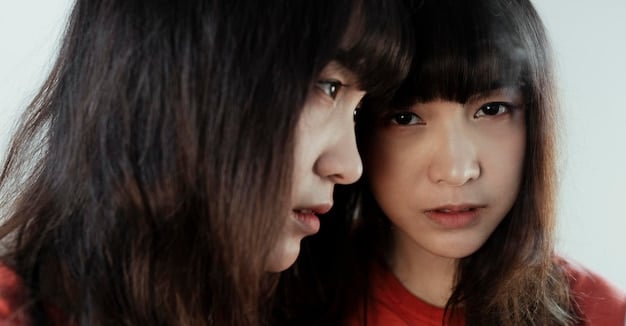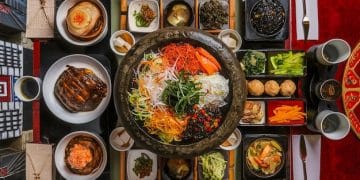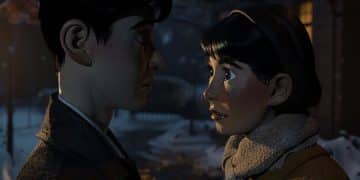Will They, Won’t They: Exploring Romantic Tension in K-Dramas

The “will they, won’t they” trope is a cornerstone of K-dramas, captivating audiences with the tantalizing dance of almost-romance, creating compelling television that keeps viewers invested in the characters’ journeys and relationships.
The question of will they or won’t they is the backbone of many a captivating K-drama. This romantic tension, expertly woven into narratives, keeps viewers glued to the screen, eagerly anticipating whether two characters will finally unite. But what makes this trope so effective, and why is it a staple in the world of Korean dramas?
Let’s delve into the art of “will they, won’t they” in K-dramas, exploring how this dynamic plays out, the elements that contribute to its success, and why it continues to resonate with audiences worldwide. We’ll uncover the magic behind the lingering glances, the near-miss moments, and the unspoken feelings that define this beloved trope.
The Allure of “Will They, Won’t They” in K-Dramas
The “will they, won’t they” dynamic is a powerful narrative tool that leverages our innate desire for connection and resolution. It’s a story about longing, anticipation, and the slow burn of feelings that simmer beneath the surface. K-dramas masterfully employ this trope, drawing viewers into a world of heightened emotions and uncertain futures.
But what specific elements contribute to the effectiveness of this trope in K-dramas? Let’s examine a few key components.
Building Tension Through Obstacles
One of the most common techniques is introducing obstacles that prevent the characters from being together. These obstacles can be external, such as disapproving families, rival love interests, or conflicting career goals. They can also be internal, such as personal insecurities, past traumas, or a fear of commitment.
- **External Conflicts:** Socioeconomic differences or family expectations can create significant barriers.
- **Internal Struggles:** Characters grappling with past hurts or fear of vulnerability add depth and complexity.
- **Communication Breakdown:** Misunderstandings and unspoken feelings contribute to the underlying tension.
These obstacles, whether external or internal, serve to heighten the suspense and make the eventual resolution—if it comes—all the more satisfying.
The Power of Near-Miss Moments
K-dramas are renowned for their use of near-miss moments—scenes where the characters almost confess their feelings, almost share a kiss, or almost find themselves in a committed relationship. These moments are carefully choreographed to maximize emotional impact, leaving viewers on the edge of their seats.
- **Accidental Encounters:** Chance meetings in meaningful locations heighten anticipation.
- **Almost-Kisses:** Lingering gazes and close proximity create palpable sexual tension.
- **Shared Vulnerability:** Moments of emotional intimacy hint at deeper feelings.
These near-misses are excruciatingly delightful, drawing out the suspense and solidifying the audience’s investment in the characters’ potential romance.
In conclusion, the allure of “will they, won’t they” in K-dramas stems from the effective use of obstacles and near-miss moments, creating a compelling narrative that teases viewers with the possibility of romance while keeping them firmly rooted in the present uncertainty.

Key Elements of a Successful “Will They, Won’t They” Dynamic
Not all “will they, won’t they” storylines are created equal. Some resonate more deeply with audiences than others. What are the key elements that contribute to a truly successful execution of this trope?
A few critical aspects elevate a simple romantic plot into an addictive, emotionally resonant experience.
Compelling Character Development
For a “will they, won’t they” dynamic to truly work, both characters must be well-developed, with their own distinct personalities, motivations, and flaws. Viewers need to be invested in their individual journeys as well as their potential relationship. This allows for a richer, more complex narrative where the potential union is less about fulfilling a trope and more about two fully realized individuals finding connection.
- **Relatable Flaws:** Characters with imperfections are more human and easier to connect with.
- **Clear Motivations:** Understanding what drives each character enhances their choices and actions.
- **Meaningful Backstories:** Backstories that inform their present-day behavior create depth and complexity.
Believable Chemistry
Perhaps the most crucial element is the on-screen chemistry between the actors. This chemistry needs to be palpable, radiating through every interaction, every glance, and every unspoken moment. Without believable chemistry, the “will they, won’t they” dynamic falls flat, failing to ignite the desired spark in the audience.
The Art of the Slow Burn
A successful “will they, won’t they” relies on a masterful slow burn. The romance should unfold gradually, building momentum over time, with each interaction adding another layer of complexity and desire. Rushing the relationship can undermine the entire premise, robbing the audience of the satisfaction of watching the characters grow and connect.
- **Subtle Gestures:** Small acts of kindness and affection hint at deeper feelings.
- **Shared Experiences:** Meaningful moments create a bond that strengthens over time.
- **Emotional Vulnerability:** Opening up and sharing personal struggles fosters intimacy.
The secret to getting it right with the “will they, won’t they” trend comes from engaging character development and believable chemistry. Without those, the trend is doomed to fail.
Examples of Memorable “Will They, Won’t They” K-Dramas
Numerous K-dramas have successfully utilized the “will they, won’t they” trope to create compelling and unforgettable stories. Let’s explore a few notable examples:
There are many examples of very successful Korean dramas that feature characters with a “will they, won’t they” narrative, and we should examine a few to understand the scope.
“Crash Landing on You”
This beloved drama tells the story of a South Korean heiress who crash-lands in North Korea and falls in love with a North Korean soldier. The cultural and political barriers between them create a significant obstacle to their relationship, making their “will they, won’t they” dynamic all the more compelling.
“What’s Wrong with Secretary Kim”
This lighthearted romantic comedy follows a narcissistic CEO and his highly competent secretary. Their initial professional relationship gradually evolves into something more, but their own insecurities and misunderstandings keep them from confessing their true feelings for much of the series.
“Guardian: The Lonely and Great God (Goblin)”
This fantasy romance tells the story of an immortal goblin and a young woman who can see ghosts. Their relationship is complicated by the goblin’s past and the woman’s destiny, creating a poignant “will they, won’t they” dynamic that resonates deeply with viewers.
Analyzing Success Factors
What do these dramas have in common? They all feature well-developed characters, believable chemistry between the leads, and a slow-burn romance that keeps viewers invested. They also introduce compelling obstacles that prevent the characters from being together, making their eventual union—if it comes—all the more satisfying. They also have an equal amount of near-miss moments that will engage the audience the entire time.
As a result, it’s easy to see why these dramas remain so popular and beloved.
The Enduring Appeal of Romantic Tension in K-Dramas
The “will they, won’t they” trope continues to be a popular and effective element in K-dramas because it taps into our universal desire for connection and resolution. It’s a story about hope, longing, and the belief that love can conquer all obstacles. These stories allow the audience to consider different points of interaction with the characters that they may experience themselves.
The trope also provides a framework for exploring complex themes such as societal expectations, personal growth, and the challenges of navigating relationships. So, the question becomes, why does this trend continue to dominate the scene?
The Power of Wish Fulfillment
K-dramas often offer a form of wish fulfillment, allowing viewers to escape into a world where true love exists and where even the most daunting obstacles can be overcome. The “will they, won’t they” dynamic heightens this sense of wish fulfillment, as viewers vicariously experience the characters’ struggles and triumphs.
Cultural Resonance
The emphasis on courtship and the slow unfolding of relationships in K-dramas resonates with cultural values in many parts of the world, particularly in Asia. This emphasis on patience and respect adds another layer of appeal to the “will they, won’t they” trope, as it aligns with traditional notions of romance.
Emotional Connection
Ultimately, the enduring appeal of the “will they, won’t they” trope lies in its ability to forge a deep emotional connection with viewers. By investing in the characters’ journeys and sharing in their hopes and fears, viewers become active participants in the story, eagerly anticipating the resolution of their romantic dilemma.
This emotional connection that they have ensures continued viewing.
Predictions for the Future of “Will They, Won’t They” K-Dramas
As K-dramas continue to evolve and explore new narrative territories, the “will they, won’t they” trope is likely to remain a staple, albeit with some interesting variations and innovations. What might the future hold for this beloved dynamic?
The trend can continue to evolve and surprise.
Subverting Expectations
We may see more K-dramas that subvert the traditional “will they, won’t they” formula, perhaps by exploring unconventional pairings or offering unexpected resolutions. This could involve portraying relationships where the characters do not wind up together, or shifting the emotional stakes of the relationship in new and challenging ways.
Deeper Exploration of Character Psychology
Future K-dramas may delve deeper into the psychological complexities of the characters involved in the “will they, won’t they” dynamic, exploring their inner fears, insecurities, and past traumas in greater detail. This could transform romantic stories into deeper psychological insights that the audience will enjoy.
Incorporating Social Commentary
We may also see more K-dramas that use the “will they, won’t they” trope to address relevant social issues, such as gender inequality, class disparities, or mental health stigmas. This approach can add another layer of depth and meaning to the story, making it more relevant to contemporary audiences.
There is always room to incorporate social commentary in the genre, especially as viewers engage.
| Key Point | Brief Description |
|---|---|
| ❤️ Building Tension | Obstacles and near-miss moments heighten anticipation. |
| 🎭 Character Development | Compelling characters are essential for the trope’s success. |
| 🔥 Chemistry | Believable chemistry fuels the “will they, won’t they” dynamic. |
| ✨ Wish Fulfillment | K-dramas offer a chance to escape into a world of true love. |
Frequently Asked Questions
It taps into our innate desire for connection and resolution. The tension keeps viewers engaged, hoping for a satisfying outcome to the characters’ relationship.
Common obstacles include disapproving families, rival love interests, conflicting career goals, personal insecurities, and communication breakdowns that test the characters.
Chemistry is crucial. Believable chemistry between the actors is perhaps the most essential element for the “will they, won’t they” dynamic to work effectively.
Yes, while prevalent in romance, the “will they, won’t they” element can be incorporated into other genres like comedy, drama, and even action, adding depth to character relationships.
A slow burn allows for deeper character development and builds anticipation. Subtly gesturas, shared experiences, and emotinal vulnerability engage the audience in anticipation.
Conclusion
The “will they, won’t they” trope is a cornerstone of K-dramas, captivating audiences with its blend of romantic tension, compelling characters, and satisfying resolutions. Whether it’s the clash of cultures in “Crash Landing on You” or the slow-burn romance in “What’s Wrong with Secretary Kim,” this dynamic continues to resonate with viewers worldwide.
As K-dramas evolve, the “will they, won’t they” trope is likely to remain a popular element, offering endless possibilities for exploring the complexities of human connection and the enduring power of love.





